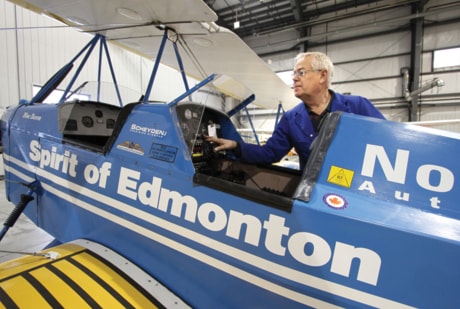The British Commonwealth Air Training Plan is a Canadian achievement at which Tom Hinderks still marvels.
When the Second World War began, Canada had five air bases. By the end of the war less than six years later, 231 training bases existed where 130,000 air crew from 15 countries had been trained, said Hinderks, executive director of the Alberta Aviation Museum in Edmonton.
Despite the monumental achievement, only the Bomber Command Museum of Canada in Nanton had planned anything to mark the 70th anniversary of the program that officially began training air crew, mechanics, technicians and other personnel in May 1940.
The aviation museum was determined to change that. And that is why the museum’s Spirit of Edmonton biplane is sitting in a hangar at Red Deer Regional Airport this week, its wings scrawled with the signatures of air force veterans from across Alberta.
To honour the achievements of the air crews, maintenance personnel and hundreds of thousands of others involved in the program, the museum launched an air tour of some of the 20 remaining training plan sites left in Alberta.
At each stop, veterans were invited to sign the wings of the replica 1930s-era biplane, parts of which have been painted for the occasion in the yellow that was standard for training aircraft during the war.
The fabric will later be stripped and preserved.
“It was such a remarkable Canadian achievement,” said Hinderks. “The whole goal (is) to honour the Canadian veterans and celebrate this piece of aviation history.
“When you start getting into it’s actually really amazing.”
Besides being a vital part of the war effort in the air, the program helped pull the country out of the Depression, introduced tens of thousands of women to the work force, and saw whole new methods of pre-fabricated construction invented.
The air tour celebrating this achievement began last Thursday at Edmonton’s Municipal Airport, itself a former training base. Hinderks piloted the plane to Lacombe and Innisfail the first day. Stops in Calgary, High River, Vulcan, Brooks and Hanna followed. Poor weather meant four other former bases in southern Alberta had to be scratched from the list. The last stop before returning home was to be former CFB Penhold.
Again weather was an issue and since landing, the Spirit of Edmonton has been grounded, safely stored in a hangar at the airport. Coping with weather is one of the many challenges of taking the stick of a fabric-covered plane that weighs 720 kilograms fully loaded.
Hinderks describes the experience as “flying a Save-On bag in a windstorm.”
The plan now is to get the plane back up in the air and home to Edmonton on Saturday. Next year, Hinderks hopes to complete the
tour of Prairie air bases, including stops in Saskatchewan and Manitoba.
For many former pilots and air crews, the celebration of the training plan will have come too late, he said.
“We should have been doing this 10 years ago, but nobody thought of things like that.
“Our veterans, our World War Two veterans, are disappearing,” he said, adding any veteran who went through the training program is at least 85 now.
“They are a treasure we’re not going to have much longer.
“My attitude on this stuff is the artifacts are one thing, the aircraft, the vehicles and all of that stuff, that can all be re-created. But we’re losing the people, and the people are the important part of the history.”
pcowley@www.reddeeradvocate.com
